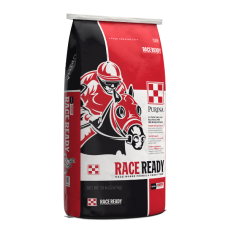Best Results
- Feeding rates will vary with size, age, temperament, health status, forage quality, climate and activity level. Feed at regular times - at least twice daily - with three daily feedings preferred. Let horses feed in a natural position from troughs with large bottoms, placed at normal head height or lower. Do not feed free-choice. Prevent the rapid eating by the horse of any feedstuff.
- Reduce and/or delay feeding a horse which is hot, excited or showing pain, has fever or diarrhea. Consult your veterinarian if any problems arise.
- Always feed a minimum of 1.0 to 1.2 lbs per 100 lbs of body weight of good quality, clean hay or the equivalent in pasture.
- Any feed changes should be made gradually over a period of 7 to 10 days. Changes in the rate of feeding should not exceed 1.0 lb per day for each horse.
- Have plenty of clean, fresh water available at all times. Provide your horse with access to salt. Maintain an effective control program for internal parasites. Have the horse's teeth examined annually and consult your veterinarian on a regular basis.
Changing To
- Make the feed change gradually over a period of 7 to 10 days.
- Mix the new feed with the old, gradually increasing the amount of the new feed while decreasing an equal amount of the old.
- Changes in the rate of feeding should not exceed 1 pound per day for each horse.
Caution
Store in a dry, well-ventilated area protected from rodents and insects. Do not feed moldy or insect-infested feed to animals as it may cause illness, performance loss or death. Feeding added selenium resulting in total diet levels in excess of 0.3 ppm is prohibited.
Crude Protein (min)..........................................12.00%
Lysine (min)........................................................0.65%
Crude Fat (min)..................................................8.00%
Crude Fiber (max)...............................................9.00%
Calcium (min)......................................................0.80%
Calcium (max).......................................................1.30%
Phosphorus (min)..................................................0.50%
Copper (min)....................................................... 55 ppm
Selenium (min)....................................................0.6 ppm
Zinc (min) ..........................................................220 ppm
Vitamin A (min)...............................................3,000 IU/lb
Vitamin E (min)...................................................150 IU/lb
Lysine (min)........................................................0.65%
Crude Fat (min)..................................................8.00%
Crude Fiber (max)...............................................9.00%
Calcium (min)......................................................0.80%
Calcium (max).......................................................1.30%
Phosphorus (min)..................................................0.50%
Copper (min)....................................................... 55 ppm
Selenium (min)....................................................0.6 ppm
Zinc (min) ..........................................................220 ppm
Vitamin A (min)...............................................3,000 IU/lb
Vitamin E (min)...................................................150 IU/lb
Best Results
- Feeding rates will vary with size, age, temperament, health status, forage quality, climate and activity level. Feed at regular times - at least twice daily - with three daily feedings preferred. Let horses feed in a natural position from troughs with large bottoms, placed at normal head height or lower. Do not feed free-choice. Prevent the rapid eating by the horse of any feedstuff.
- Reduce and/or delay feeding a horse which is hot, excited or showing pain, has fever or diarrhea. Consult your veterinarian if any problems arise.
- Always feed a minimum of 1.0 to 1.2 lbs per 100 lbs of body weight of good quality, clean hay or the equivalent in pasture.
- Any feed changes should be made gradually over a period of 7 to 10 days. Changes in the rate of feeding should not exceed 1.0 lb per day for each horse.
- Have plenty of clean, fresh water available at all times. Provide your horse with access to salt. Maintain an effective control program for internal parasites. Have the horse's teeth examined annually and consult your veterinarian on a regular basis.
Changing To
- Make the feed change gradually over a period of 7 to 10 days.
- Mix the new feed with the old, gradually increasing the amount of the new feed while decreasing an equal amount of the old.
- Changes in the rate of feeding should not exceed 1 pound per day for each horse.
Caution
Store in a dry, well-ventilated area protected from rodents and insects. Do not feed moldy or insect-infested feed to animals as it may cause illness, performance loss or death. Feeding added selenium resulting in total diet levels in excess of 0.3 ppm is prohibited.
ENERGY DEMANDS in the race horse are extremely high, so the delivery of additional calories becomes paramount. This additional digestible energy must be provided in a manner that maximizes performance while helping to maintain digestive tract health and function. Purina® Race Ready® Horse Feed is designed to deliver a large amount of energy to these hard-working athletes, while addressing digestive tract concerns by distributing the calories over several sources (vegetable oils, digestible fiber such as beet pulp, high quality natural grains and molasses). Research has shown that the utilization of vegetable oils and highly fermentable fibers, such as beet pulp, can be of benefit to the hardworking equine athlete.
CONTAINS THE PROPRIETARY PURINA® AMPLIFY® HIGH FAT NUGGET
Thanks to extensive research and field testing, Purina has learned how certain nutritional advantages can help horses be highly active and productive during their lifetimes, even with the added stress of training regimens and performance expectations.
The Purina® Amplify® Nugget is a palatable, high-fat, extruded particle providing calories for weight gain, performance, lactation and sales prep in a nutritionally balanced formulation that has controlled carbohydrate levels.
This proprietary feed supplement can be found only in Purina® Horse Feeds including Race Ready® Horse Feed.
CONTAINS THE PROPRIETARY PURINA® AMPLIFY® HIGH FAT NUGGET
Thanks to extensive research and field testing, Purina has learned how certain nutritional advantages can help horses be highly active and productive during their lifetimes, even with the added stress of training regimens and performance expectations.
The Purina® Amplify® Nugget is a palatable, high-fat, extruded particle providing calories for weight gain, performance, lactation and sales prep in a nutritionally balanced formulation that has controlled carbohydrate levels.
This proprietary feed supplement can be found only in Purina® Horse Feeds including Race Ready® Horse Feed.
Purina Race Ready Horse Feed
- Brand: Purina Animal Nutrition
- Product Code: 8179
- Weight : 50.00lb
- Availability: In Stock
Tags: Horse Feed, Horse Feed
